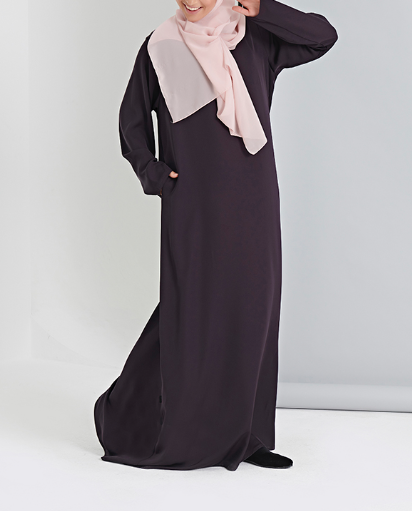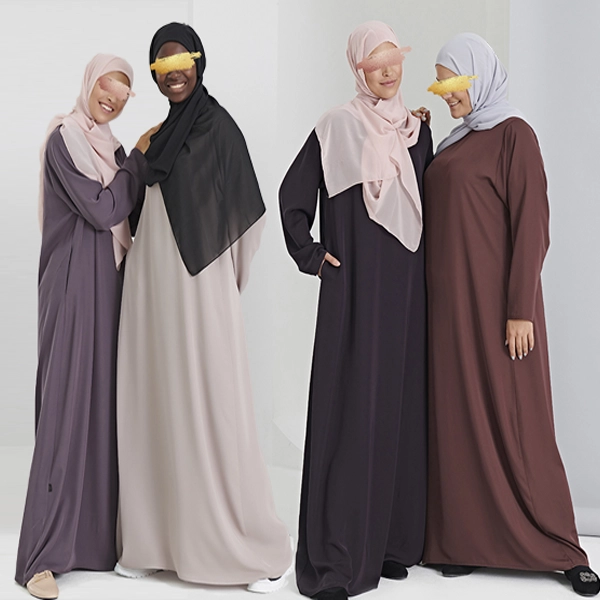The abaya is an outer garment worn by women as a symbol of cultural identity and religious belief. This modest attire is deeply rooted in Islam and history.
But what is an abaya? It’s a traditional black or dark coloured cloak worn by Muslim women. When we look at its history and evolution, it’s more than just a garment – it’s a symbol of faith, modesty, and cultural identity.
Today, this iconic piece has evolved while staying true to its historical roots and modest traditions.
This article will uncover the deep-rooted history, contemporary appeal, cultural significance, and how abayas remain a versatile piece of modesty and grace.

What is an Abaya Dress?
An abaya is a black, flowing dress that covers a woman’s body entirely from her shoulders, except for her face, hands, and feet. However, the black abaya has become a timeless fashion piece worldwide without compromising modesty.
While the traditional black attire remains a symbol of cultural pride in many regions, colourful abayas—adorned with locally sourced materials and intricate designs—are equally significant in expressing cultural heritage in regions like Southeast Asia and North Africa.
Understanding the Historical Roots of An Abaya
Just as much as the abaya carries significant importance in Muslim women’s lives, it also carries a rich history. While its exact origins are unclear, similar garments have been worn in ancient civilizations like Mesopotamia, and the abaya evolved over centuries into a symbol of faith and modesty in regions such as the Arabian Peninsula.
The Abaya transformed from a practical, protective garment to a versatile clothing that symbolises religious significance and cultural emphasis by adapting various religious and social contexts throughout centuries.

Cultural Significance of an Abaya
Apart from the rich history of the abaya, it also has a profound cultural impact. Abaya symbolizes the values of Islamic beliefs, modesty, and faith. Muslim women around the world consider the abaya as a reflection of cultural traditions and Islamic principles of modesty.
It goes above and beyond regions, Muslim women across the world, including Southeast Asia, Africa, and the Arabian Gulf embrace this elegant piece of clothing wholeheartedly.
Abaya is a unifying symbol of modesty across the diverse cultures of the Muslim world, while also allowing women to express themselves through different styles and traditions.
The Evolution of the Abaya: What is an Abaya Today?
To actually grasp the depth of this timeless piece one needs to understand and learn the historical evolution of the abaya or the Islamic dress. While it served as a protective garment against harsh climates in desert regions, it has evolved so much since then.
As Islam spread, the deeper meaning of wearing an abaya became more profound, highlighting faith and modesty. The abaya is now part of contemporary fashion while preserving the core values of religious modesty.
Various abaya fabrics and modern designs reflect the overall adaption to the latest fashion trends, showing how the abaya honours traditions, and cultures, while also upholding modesty.

Abaya Fabric and Its Evolution
As abayas evolved, the fabric choices too evolved to match the diversity and cultures without compromising modesty. Traditionally, the fabric used for abayas was durable, simple, and designed for comfort—perfect for the hot climates where they originated.
The modern abaya has opened the door for fashion infusion with traditional flair. Modern abayas are available in various fabrics to provide both comfort and style while adhering to Islamic principles and modesty.
From lightweight fabrics to elegant chiffons, a variety of materials work well for abayas, making them a versatile piece of clothing that embraces both fashion trends and modesty.
What does the Quran say about abaya?
While the abaya itself is not explicitly mentioned in the Quran, the principles of modesty are emphasized in Surah Al-Ahzab, which encourages women to cover themselves modestly. The abaya has become one of the many ways Muslim women express these values.
“O Prophet! Ask your wives, daughters, and believing women to draw their cloaks over their bodies. In this way, it is more likely that they will be recognized ˹as virtuous˺ and not be harassed. And Allah is All-Forgiving, Most Merciful.” [33:59]
What are the benefits of wearing an abaya in Islam?
As mentioned, Islam does not specifically say “abaya” but the dress meets all the principles of Islamic clothing. Therefore, you can enjoy the following benefits by wearing an abaya:
- It makes you feel and look modest.
- It’s a loose-fitting garment with non-body hugging material, as emphasised in Islamic teachings.
- An abaya allows you to proudly carry your cultural and religious roots.
- Abaya provides comfort, especially, during summer, abaya works best to combat the heat.
Is Wearing an Abaya Compulsory?
No, it’s not. But you’re encouraged to wear modest clothing in Islamic principles, and the abaya is one of many dresses that fits the principle.

The Abaya in Modern Fashion: Style and Trends
Modern abaya designs creatively integrate fashion elements like embroidery and sleek cuts, while always maintaining the cultural and religious values of modesty. These designs empower women to showcase their Muslim identity while expressing their individuality in fashion.
These abayas come in a variety of styles, featuring elegant drapes, creative cuts, and detailed embellishments, ensuring Muslim women stay fashionable while maintaining their modesty and values.
Difference Between Abaya and Other Garments
Abaya is a loose garment that covers your body from your shoulder to your feet. You have to wear a hijab to cover your hair. But other garments, such as burqa and jilbab cover your entire body.
What is the difference between abaya and burqa?
Both are modest garments following Islamic principles but unlike abayas, the burqa covers the entire body from face to feet. While Muslim women in North Africa, Southeast Asia, and the Middle East predominantly wear abaya, the burqa is commonly worn by women in Afghanistan and some parts of Pakistan.
What is the difference between jilbab and abaya?
Abaya and jilbab serve the same purpose, however, they are different in terms of coverage and style. The jilbab is a cloak-like outer garment worn over the body to cover the shape.
Overall, both garments meet the Islamic principles of modesty, the jilbab provides full coverage over the dress worn underneath, while the abaya is paired with a hijab (head scarf) to get complete coverage for modesty.
Types of Abaya
Abays come in different styles and designs such as:
- Open abaya
- Closed abaya
- Belted abaya
- Kimono-style abaya
- Butterfly-style abaya
- Kaftan abaya
- Embroidered abaya
- Layered abaya
In addition to these styles, custom tailored abayas are also popular among women who prefer a DIY approach.

How To Style an Abaya
Styling an abaya has various fashion possibilities that also maintain modesty. If you make the right styling approach, you will be able to create a versatile look for any occasion. Here are some fashion tips:
- Choose the right style of abaya – from open abaya to butterfly abaya to match your mood and the occasion.
- Tailor your abaya to fit your size – keep it modest, but make sure it’s not too lengthy.
- Add the right scarf – use scarves in different colours, patterns, and styles while keeping them modest.
- Accessories to accentuate – you can use necklaces, earrings, and brooches to enhance the overall look.
- Comfortable shoes – pair your abaya with the right pair of shoes that match the occasion.
By following these tips, you can enhance your abaya to match the occasion while balancing personal expression and modesty.
Are abayas tailored to fit different body sizes?
Yes. For instance, you can have a layered abaya with a belt separately to make it fit your size, it’ll not only cover you up but also make you look elegant. Likewise, many fashion elements can tailor your abaya to match your size while keeping it fashionable and modest.
Can abayas be paired with other traditional wear?
Absolutely, but to achieve that fashion sense, you need an open abaya to mix and match with a traditional salwar kameez for religious or cultural events.
Can abayas be worn for formal occasions?
Of course! They’re ideal for formal occasions as they make you look elegant and sophisticated at the same time. Detailed embroidery, elegant cut, and luxury material can enhance the look of the abaya to suit the event.
How do I care for my abaya?
- Make sure to follow the care label on your abaya.
- Consider air drying to keep the shape and quality of your abaya.
- Hand wash or choose the delicate cycle option when washing your abaya.
- Try to find the right detergent.
Where can I buy quality abayas?
If you’re looking for modern abayas that uphold modesty, AHD London offers a curated selection of various styles and designs.
At AHD London, we believe that every abaya is more than just a garment—it’s a reflection of faith, culture, and personal style. Our collection seamlessly blends traditional values with modern design, ensuring that every woman feels both elegant and modest on any occasion.
